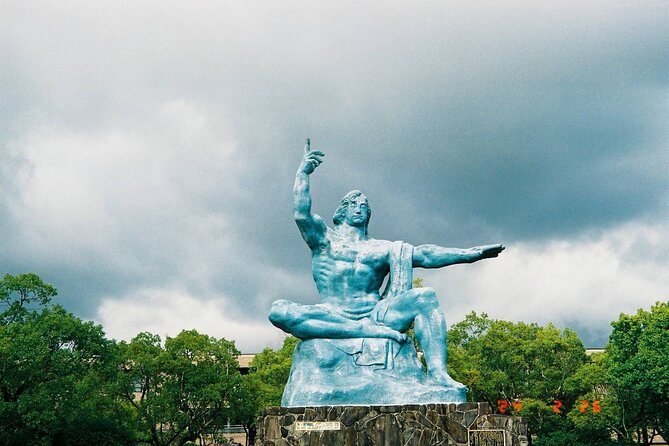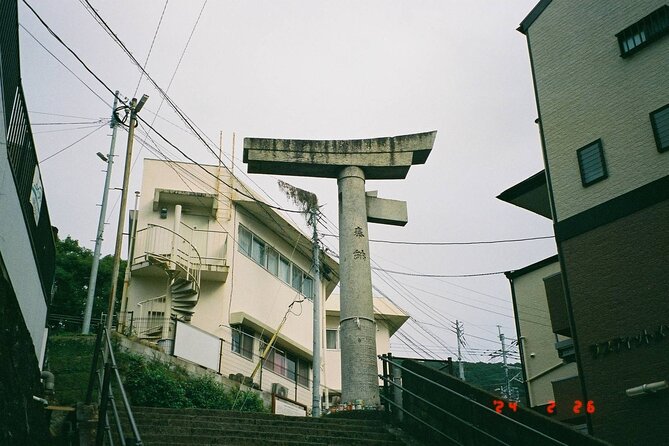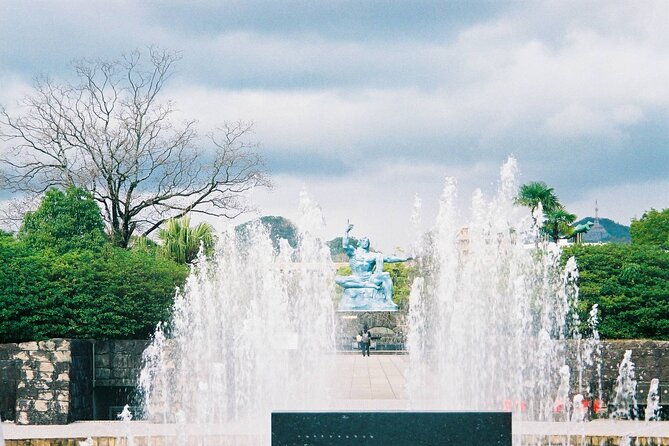Nagasaki’s Peace Park and Atomic Bomb Museum stand as poignant reminders of the city’s tragic past. Visitors can explore the haunting memorials and exhibits that chronicle the devastating impact of the atomic bomb dropped on August 9, 1945. Through personal testimonies and powerful displays, the museum educates and inspires reflections on the horrors of nuclear warfare, while the park’s symbolic structures foster a commitment to peace and disarmament. But the story doesn’t end there – there’s more to discover about Nagasaki’s resilience and the lessons it continues to offer the world.
Good To Know

- The Nagasaki Peace Park and Atomic Bomb Museum serve as poignant memorials to the victims of the 1945 nuclear attack, educating visitors about the tragedy.
- The Nagasaki Atomic Bomb Museum exhibits personal belongings, models, and survivor testimonies to illustrate the catastrophic impact of the atomic bomb.
- The Peace Statue in the park symbolizes Nagasaki’s unwavering desire for lasting peace and commitment to nuclear disarmament.
- The park offers serene spaces for reflection, with the Names Repository honoring the over 70,000 lives lost in the bombing.
- Nagasaki’s resilience and reconstruction after the tragedy showcase the city’s enduring spirit and its role in promoting global peace.
The Haunting History of Nagasaki
Although Nagasaki is now a vibrant city, it bears the scars of a devastating past.
On August 9, 1945, the city was devastated by the second atomic bomb dropped on Japan during World War II. The blast instantly killed over 70,000 people and destroyed much of the city. The radiation from the bomb continued to claim lives for years afterwards.
Today, the Nagasaki Peace Park and Atomic Bomb Museum stand as solemn reminders of this tragic event, honoring the memory of those lost and educating visitors about the immense human cost of nuclear warfare.
You can also read our reviews of more museum experiences in Nagasaki
Exploring Peace Park

After passing through the gates of Nagasaki Peace Park, visitors are immediately struck by the serene yet somber atmosphere. The park serves as a poignant memorial to the devastating atomic bombing of the city, with various monuments and sculptures reflecting the horrors of that day. At the center stands the Nagasaki Atomic Bomb Museum, where harrowing exhibits chronicle the event and its aftermath. Nearby, visitors can explore air raid bunkers and the river area, gaining a deeper understanding of the city’s resilience and the human cost of nuclear warfare.
| Feature | Details |
|---|---|
| Duration | Approx. 3 hours |
| Group Size | Private tour, only your group |
| Operator | Nagasaki Odyssey |
| Price | From $105.00 per person |
| Cancellation | Free up to 24 hours before |
The Atomic Bomb Museum

The Nagasaki Atomic Bomb Museum stands as a solemn testament to the city’s darkest hour. Its exhibits powerfully convey the devastation unleashed by the atomic bomb on August 9, 1945.
Visitors can:
- View personal belongings of victims, preserved to honor their memory.
- Examine models and diagrams illustrating the bomb’s catastrophic impact.
- Listen to audio recordings of survivors recounting their harrowing experiences.
The museum’s purpose isn’t to assign blame, but to educate and inspire a commitment to peace.
Its poignant displays serve as a stark reminder of the immense human toll of nuclear warfare, urging visitors to reflect on the horrors of the past and work towards a future free from such tragedies.
Remembering the Victims
Within the Nagasaki Peace Park, visitors can find poignant reminders of the victims who perished in the atomic bombing.
The Peace Statue, with its outstretched arms, symbolizes the city’s desire for lasting peace. Nearby, the Names Repository contains over 70,000 names of those who died, a somber testament to the scale of the tragedy.
The Children’s Peace Monument, inspired by the story of Sadako Sasaki, honors the young lives lost.
Throughout the park, trees, monuments, and memorials create spaces for reflection and remembrance, ensuring the victims’ legacies aren’t forgotten.
Lessons From the Tragedy

Though the devastation of the atomic bombing was immense, the Nagasaki Peace Park and Atomic Bomb Museum offer powerful lessons for visitors.
The exhibits highlight:
-
The human cost of nuclear warfare, with personal accounts and artifacts that humanize the tragedy.
-
The ongoing efforts to promote nuclear disarmament and world peace, emphasizing the park’s role as a symbol of hope.
-
The importance of educating future generations about the catastrophic impact of nuclear weapons, to ensure such horrors are never repeated.
These lessons resonate profoundly, inspiring reflection on the fragility of life and the urgent need for global cooperation and non-violence.
Nagasaki’s Resilience
Amidst the sobering lessons drawn from the Nagasaki tragedy, the city’s resilience shines through, embodied in its remarkable reconstruction and enduring spirit.
Despite the immense devastation, Nagasaki has risen from the ashes, transforming itself into a symbol of hope and peace.
The Nagasaki Peace Park, with its somber monuments and the Atomic Bomb Museum, stands as a testament to the city’s determination to never forget and to promote global nuclear disarmament.
Through this powerful reminder of the past, Nagasaki inspires visitors to reflect on the fragility of life and the importance of fostering peace and understanding among all people.
Panoramic Views From City Hall
The city hall observatory offers visitors a bird’s-eye view of Nagasaki’s vibrant cityscape. From this vantage point, guests can:
- Marvel at the picturesque harbor and its surrounding hills.
- Spot the iconic Glover Garden and the Dejima historic district.
- Gain a deeper understanding of Nagasaki’s geography and how the city has adapted to its unique terrain.
This panoramic perspective provides a welcome contrast to the somber atmosphere of the Nagasaki Peace Park and Atomic Bomb Museum.
The observatory allows visitors to appreciate the city’s resilience and modern development in the wake of the atomic bombing.
Beyond the Tour’s Highlights
While the tour’s main highlights showcase Nagasaki’s poignant history and resilience, there’s more to uncover beyond the scheduled stops. Tim, the knowledgeable guide, often tailors the experience based on guests’ interests. He may lead visitors through narrow alleyways, introducing local shops and eateries, or recommend museums that delve deeper into the city’s culture and traditions. The flexibility of the tour allows for spontaneous discoveries, creating a more immersive and personalized experience.
| Potential Additions | Description |
|---|---|
| Local Markets | Explore bustling markets showcasing regional produce and crafts |
| Glover Garden | Stroll through this historic Western-style estate |
| Oura Catholic Church | Marvel at the stunning 19th-century architecture |
| Suwa Shrine | Experience the serenity of this important Shinto shrine |
| Dejima Island | Learn about Nagasaki’s unique history as a trading port |
Frequently Asked Questions
How Accessible Is the Tour for Visitors With Mobility Issues?
The tour is generally accessible for visitors with mobility issues. It involves walking and using the Nagasaki Tram, but the guide can make flexible arrangements to accommodate individual needs. Visitors should inquire about specific accessibility requirements when booking the tour.
Are Audio Guides or Multilingual Resources Available During the Tour?
The tour doesn’t mention audio guides or multilingual resources. However, the knowledgeable guide, Tim, who’s fluent in English, is available to provide personalized insights and translation assistance throughout the experience.
Can Visitors Take Photographs Inside the Atomic Bomb Museum?
Visitors are generally allowed to take photographs inside the Atomic Bomb Museum, but they’re advised to avoid using flash as it may disturb other visitors and disrupt the solemn atmosphere of the museum.
Is There a Recommended Attire or Dress Code for the Tour?
There’s no formal dress code for the tour, though comfortable walking shoes and weather-appropriate clothing are recommended. The focus is on the educational experience, not attire, so visitors can dress casually and comfortably.
Are There Any Age Restrictions or Considerations for the Tour?
The tour has no age restrictions, but it may not be suitable for very young children due to the sensitive historical content. Parental discretion is advised, and the tour guide can provide recommendations based on the group’s needs.
The Sum Up
Nagasaki Peace Park and the Atomic Bomb Museum stand as solemn reminders of the atomic bomb’s horrors. Visitors can reflect on the tragedy and reaffirm the commitment to peace and nuclear disarmament. The city’s resilience in the face of unimaginable devastation serves as an inspiration for building a more peaceful world.
More Museum Experiences in Nagasaki
More Tour Reviews in Nagasaki
- Huis Ten Bosch Ticket in Nagasaki Japan
- Hasami Ware 2-Day Tour With Special Guide ~ 400 Years History and Modern Daily Use Pottery ~
- Nagasakis Hidden Gems: Private & Personalized Walking Experience
- Sasebo Private Customizable Full Day Tour
- Private Transfer From Sasebo Cruise Port to Fukuoka City Hotels
- Sunset Beach Dinner
Not for you? Here's more nearby things to do in Nagasaki we have reviewed
- Huis Ten Bosch Ticket in Nagasaki Japan
- Hasami Ware 2-Day Tour With Special Guide ~ 400 Years History and Modern Daily Use Pottery ~
- Nagasakis Hidden Gems: Private & Personalized Walking Experience
- Sasebo Private Customizable Full Day Tour
- Private Transfer From Sasebo Cruise Port to Fukuoka City Hotels
- Sunset Beach Dinner
- Make Lunch With Onsen Kitchen in Unzen
- Nagasaki Airport (NGS) to Nagasaki – Round-Trip Private Transfer
- Sea Kayaking and Beach Clean up in Ojika Island Nagasaki
- Nagasaki Heritage Trail: Cathedrals, Bridges & Chinatown
- Mochitsuki Rice Cake Making Experience in Ojika Island
- Nagasaki Airport (NGS) to Nagasaki – Arrival Private Transfer
